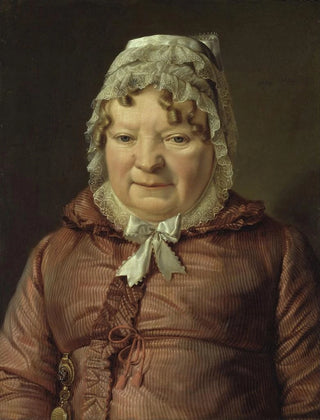Art print | Portrait of Captain von Stierle-Holzmeister's mother - Ferdinand Georg Waldmüller


View from behind

Frame (optional)
Introduction captivante
The "Portrait of Captain von Stierle-Holzmeister's mother" by Ferdinand Georg Waldmüller is an iconic work that transcends a simple portrait to immerse us in the intimacy of a maternal relationship. Created in the 19th century, this painting invites us to explore the nuances of affection and dignity, while offering a fascinating glimpse into Austrian society of the time. Waldmüller, a master of realism, manages to capture not only the physical features of his subject but also the very essence of her character. The art print of this work allows for rediscovering an era when art was a means of expressing the deepest emotions and family values.
Style and uniqueness of the work
This portrait stands out for its intimate approach and refined technique. Waldmüller uses a palette of warm, earthy colors that confer an aura of serenity and strength to his subject. The natural light, subtly manipulated, caresses the mother's face, highlighting her delicate features and her gaze filled with wisdom. Every detail, from the fold of her dress to the texture of her hair, is carefully observed, demonstrating the artist's technical skill. The background, meanwhile, remains blurred and stripped down, allowing the viewer to focus on the essence of the character. This work does not merely depict a maternal figure; it also evokes an atmosphere of tenderness and respect, paying homage to the central role of the mother in family life.
The artist and his influence
Ferdinand Georg Waldmüller, born in 1793 in Vienna, is one of the most influential representatives of the Austrian realist movement. His career, rich and varied, spans several decades during which he evolved while remaining faithful to his style. Waldmüller was influenced by the artistic currents of his time, notably Romanticism, but also forged a unique identity, blending meticulous observation with emotional sensitivity. He has often been considered a precursor to Impressionism, thanks to his way of capturing the

Matte finish

View from behind

Frame (optional)
Introduction captivante
The "Portrait of Captain von Stierle-Holzmeister's mother" by Ferdinand Georg Waldmüller is an iconic work that transcends a simple portrait to immerse us in the intimacy of a maternal relationship. Created in the 19th century, this painting invites us to explore the nuances of affection and dignity, while offering a fascinating glimpse into Austrian society of the time. Waldmüller, a master of realism, manages to capture not only the physical features of his subject but also the very essence of her character. The art print of this work allows for rediscovering an era when art was a means of expressing the deepest emotions and family values.
Style and uniqueness of the work
This portrait stands out for its intimate approach and refined technique. Waldmüller uses a palette of warm, earthy colors that confer an aura of serenity and strength to his subject. The natural light, subtly manipulated, caresses the mother's face, highlighting her delicate features and her gaze filled with wisdom. Every detail, from the fold of her dress to the texture of her hair, is carefully observed, demonstrating the artist's technical skill. The background, meanwhile, remains blurred and stripped down, allowing the viewer to focus on the essence of the character. This work does not merely depict a maternal figure; it also evokes an atmosphere of tenderness and respect, paying homage to the central role of the mother in family life.
The artist and his influence
Ferdinand Georg Waldmüller, born in 1793 in Vienna, is one of the most influential representatives of the Austrian realist movement. His career, rich and varied, spans several decades during which he evolved while remaining faithful to his style. Waldmüller was influenced by the artistic currents of his time, notably Romanticism, but also forged a unique identity, blending meticulous observation with emotional sensitivity. He has often been considered a precursor to Impressionism, thanks to his way of capturing the






